How Ofter to Feed a Dove Fledgling
Guest Post by Ashley Dietrich
Most pigeons and doves, when rescued, are dehydrated and starved (and often injured). Many will immediately drink and eat given the opportunity. If they don't, that is a serious signal that expert help is needed. PLEASE connect with a pigeon-friendly rehabber or rescuer to help the bird you've found. It can mean the difference between their life and death. It is important to note that cases of severe starvation and emaciation must be handled expertly – with rehydration being of utmost importance. Too much food too fast or the wrong food can be deadly. These cases need expert care and possibly liquid formula feeding. Please join and post to our Palomacy Help Group for 24/7 assistance. You can also find pigeon-friendly rehabbers on our rescue map, at Find a Wildlife Rehabilatator (always ask about their pigeon policy as some will only euthanize rather than help) and search for an avian vet. (Also see Palomacy's guidelines for How to Care for a Rescued Pigeon)

Click here
It is important to know when and what NOT to feed. Birds should never be offered milk (they are not mammals), and for the most part should not have things like bread, oatmeal, and other low nutrient foods. Feeding the wrong thing can worsen a situation and even kill the animal by disturbing the digestive system – especially an animal already in distress. Never attempt to syringe feed or tube feed a bird without direct guidance from an experienced expert. Never pour liquid into the beak or force water. It is easy to aspirate a bird doing any of those things. Never feed a dehydrated or cold bird. Protocol is to first make sure they are warm, then hydrated, then address food intake. The best advice is always to get expert help, preferably someone local who can personally examine the bird and assess the situation before acting. If any pigeon (especially an adult) is not self-feeding, it is imperative to first determine the cause. A bird may refuse food for many reasons: immaturity, pain, stress, illness, disability, weakness, etc.
Supportive Care
Newly rescued pigeons or doves or our own pets sometimes need supportive care to help them through a crisis. A pigeon or dove that isn't eating needs to be safely confined (protected from predators as well as flockmates that may bully or injure a weak bird), kept warm and quiet and encouraged or assisted to drink and eat. If you are helping a bird in this state, please engage an expert for one-on-one guidance. The following information is no replacement for expert help.
Hydration
Dehydration is extremely common in rescued birds. Some will immediately drink when water is provided. If a pigeon appears especially weak/tired, dissolve a small pinch of salt and a small pinch of sugar in the water you provide to help restore electrolytes. For an adult or juvenile pigeon who is not drinking, a safe way to encourage them is to dip the tip of their beak into a water dish and hold the water there for 20-30 seconds.
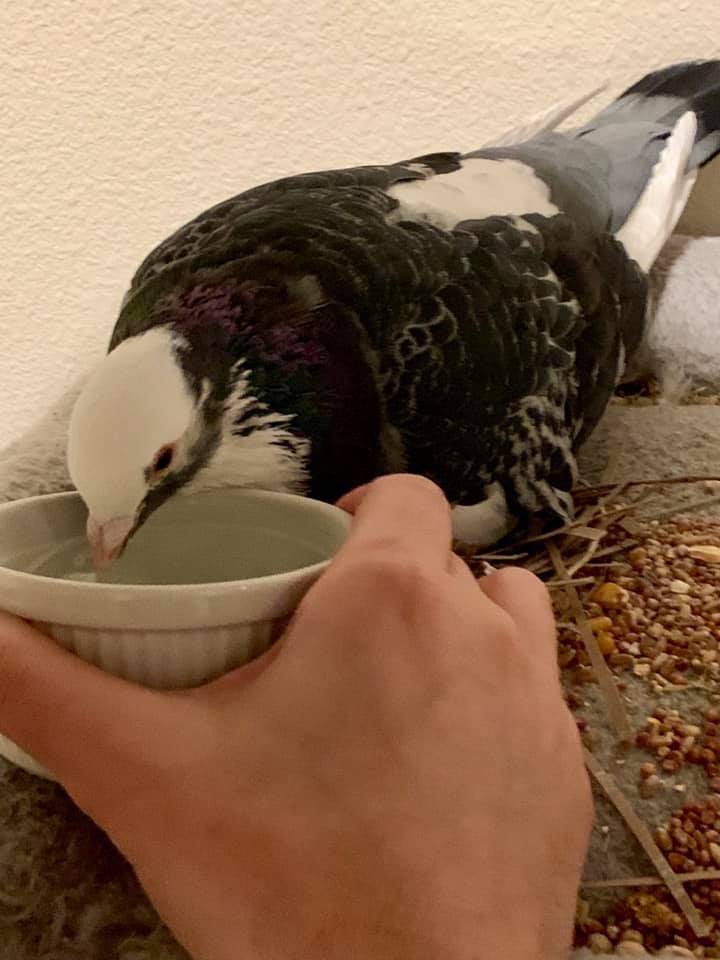
Pigeon Alfred leaning in to drink
The pigeon may immediately drink. If they do, you'll know because they will plunge their beak forward and suck up water. Or the pigeon may not move at all or may move their head away. If they don't drink or move their head away, try a couple of more times. Often we are able, after a couple of attempts, to encourage the bird to drink. Sometimes just the sound of running water along with the offered dish will help. (Pigeons totally understand the sound of water.) Be gentle and patient, and do not force down the head or submerge more of the beak. For juveniles learning to drink, you can first try dipping your finger in the water to encourage them to dip their own beak. It will take multiple tries for them to master the skill. If the pigeon is not drinking- neither on their own nor with your help, you may need emergency avian vet care to save the pigeon.
Myth-buster: Despite what is posted & often reposted on the web, pigeons do not need water 1″ deep to drink. They can suck up water from a nearly flat puddle if need be.
The Myth of Grit
One of the first questions people always ask when they find a bird is, What about grit? Pigeons and doves don't actually need grit to digest their food. (That is a myth.) We actually see a lot more problems from birds overeating grit (which is salty and yummy) and becoming impacted than we ever have from a lack of grit. The only benefit of grit (or crushed oyster shells) comes in the form of minerals and calcium which birds definitely need long-term (also available through avian vitamin and mineral supplements like Nekkton's and LeFeber's).
Feeding
For a found pigeon or dove, offer parakeet or wild bird type food (sold in supermarkets and pet supply stores if you do not have quick access to a pigeon/dove mix, sold in feed stores rather than pet stores) in a shallow, heavy flat-bottom dish (or the next closest thing). Offer water in a straight sided and/or heavy dish – ramekins work great.
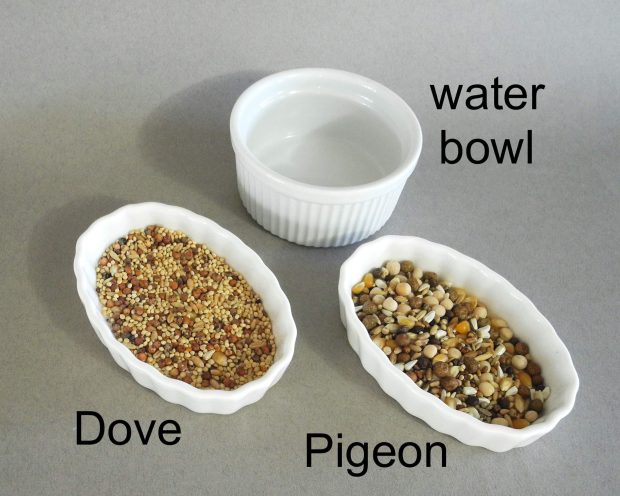
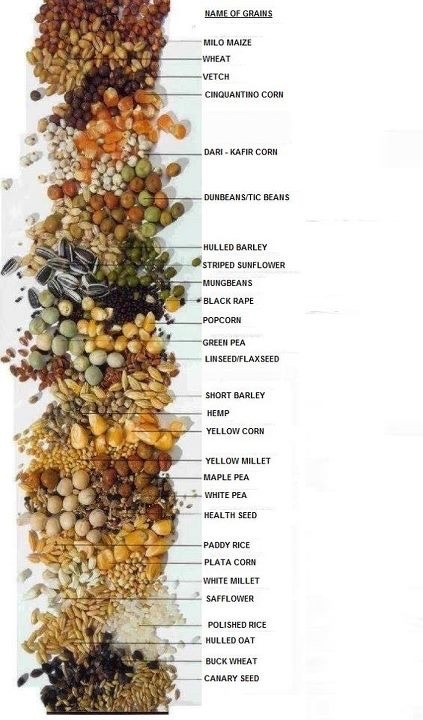
Grains that pigeons & doves eat
Pigeons and doves are granivores meaning they primarily eat grains and seeds but they can also eat chopped vegetables and fruits. If you don't have access to bird food, you can short-term feed a rescued pigeon or dove minced carrots, broccoli, cauliflower, edamame, lima beans, bell peppers, corn, unsalted chopped nuts, uncooked popcorn kernels, unsalted sunflower seeds (shelled or not), rice, quinoa or lentils (cooked or raw).
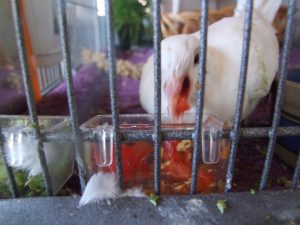
Ringneck dove Pierre eating chopped bell peppers
If it is determined that a bird, once warm and hydrated, is unable to self-feed and needs to be hand fed, a safe way to supplement food to restart their digestive system is to gently hand-feed frozen peas (not canned) that have been thawed in warm water. (Never microwave anything you are going to give a bird as the risk of accidentally burning them is very high.) Wrap the bird in a towel, not too tight, gently open the beak, and put in a pea. They will automatically swallow it down very safely. (There is no choking hazard like there is with syringe or tube-feeding.) Start slow, with only about 5-6 peas at first. Wait an hour or so to see that they poop. If they do, it means that the food is moving through their system and it is safe to give another 5-6 peas. If they don't, offer more water but don't hand-feed any more. This can be stressful to the bird, and it is better to hand-feed only small amounts every few hours until, ideally, the pigeon begins self-feeding or you get them to an expert. (Learn more about long-term feeding and caring for pigeons here.)
Ashley & Wyatt demonstrate hand-feeding
Juvenile Birds
People are often suprised to learn that a pigeon they rescued is still an immature juvenile, just learning to self-feed, because they can be as big as full grown birds and look adult to an untrained eye. If the pigeon squeaks, it is for sure a juvenile. (Pigeons youngsters are called "squeakers" and stop squeaking around 6-8 weeks old.) If the pigeon has little gold threads amongst their feathers – juvenile. If they flutter their wings and thrust their beak at you or your hand- juvenile. They are used to being fed and need help to learn to self-feed. If you have rescued a nestling (not yet feathered) they will need to be fed in a way that mimics how their parents feed them. Please visit this website www.PigeonRescue.co.uk for lots of detailed, trustworthy info.
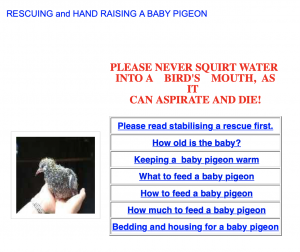
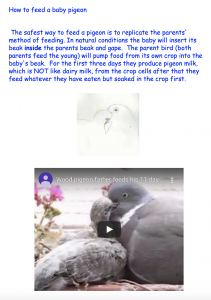
Hungry rescued King pigeon fledgling Athena begs to be fed
Learning to self-feed with a little help from a friend
For a healthy juvenile learning to self-feed, peas can be used as a supplement, as an alternative to formula (for someone with no access to an expert to tube feed). Again, each case warrants specific consideration. To encourage a youngster to eat, scatter seed on a towel, and offer a seed dish as well, tapping your finger to mimic beaking food. If possible, put the bird in view of other birds eating, so he can learn by example. (Playing the videos above for a pigeon youngster while tapping your finger in bird seed will often help them learn!) Patience is key – they need support and encouragement as they learn to self-feed. Supplemental feeding may be needed until they are able to eat enough on their own. And please, don't keep and raise up a feral (wild) pigeon youngster in your home. Get them to a pigeon-friendly wildlife rehabber so they can grow up to live wild and free. (The pigeon youngsters shown in these videos are unreleasable.) If you raise a feral pigeon youngster in your home, they will become imprinted on humans, they will be unreleaseable and they will need YOU to provide a wonderful home for 10+ years.
Please join and post to our Palomacy Help Group for 24/7 assistance. You can also find pigeon-friendly rehabbers on our rescue map, at Find a Wildlife Rehabilatator (always ask about their pigeon policy as some will only euthanize rather than help) and search for an avian vet.
Source: https://www.pigeonrescue.org/2019/10/30/how-when-to-feed-a-pigeon-who-isnt-eating/
0 Response to "How Ofter to Feed a Dove Fledgling"
Post a Comment